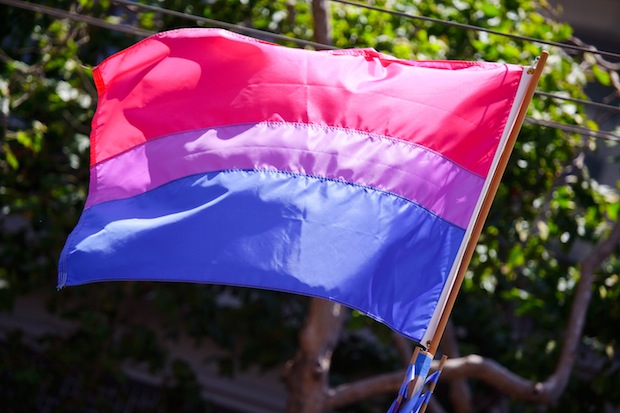Tackling the stigma of bisexuality
By Leah Pickett

Tackling the stigma of bisexuality
By Leah Pickett
October is LGBTQ History Month – a time to honor gay rights pioneers of the past and celebrate the monumental progress that has been made.
But prejudice against the “B” in LGBTQ, bisexuality, still holds a tremendous amount of power, as its legitimacy continues to be called into question in straight and queer communities alike.
People who identify as bisexual – that is, having an attraction to both genders, although not always simultaneously or equally – are often called liars, branded as promiscuous, or shamed into invisibility by those who don’t understand how bisexuality could be anything more than a “phase” or a “coverup.”
A groundbreaking report from the San Francisco Human Rights Commission has defined the bisexual “erasure” problem this way:
“Bisexuals experience high rates of being ignored, discriminated against, demonized, or rendered invisible by both the heterosexual world and the lesbian and gay communities. Often, the entire sexual orientation is branded as invalid, immoral, or irrelevant. Despite years of activism, the needs of bisexuals still go unaddressed and their very existence is still called into question. This erasure has serious consequences on bisexuals’ health, economic well-being, and funding for bi organizations and programs.”
Ultimately, bisexuality myths only serve to amplify stereotypes about people who don’t settle at one end of the homo/hetero binary, while also perpetuating stigmas that keep “biphobia” alive and well.
Myth 1: You’re either gay, straight, or lying. Bisexuality does not exist.
In addition to being rude and presumptuous, this oft-used maxim is just flat out wrong in dismissing all bisexual people as wolves in sheep’s clothing.
Granted, many bisexual individuals hold a preference. For example, I identify as bisexual, and while I hold a sexual attraction to both genders, I tend to be more romantically attracted to men. This is why I choose the term “heteroromantic bisexual.” Others may prefer another descriptor under the bisexual umbrella, or choose not to label themselves at all.
Myth 2: Bisexuality is just one stage in the coming out process for gays and lesbians.
Of course, some people do come out as bisexual before eventually coming out as gay or lesbian to their friends and family. But to stereotype all bisexuals as being in some phase of transition, or just “experimenting” before finally accepting themselves as exclusively gay or straight, is not only an unfair and prejudicial assumption, but a scientifically inaccurate one as well.
A number of studies, including those conducted by renowned sexologist Alfred Kinsey, have shown that sexuality is fluid and exists on a spectrum. In 1948, Kinsey’s work “Sexual Behavior in the Human Male” found that “46 percent of the male population had engaged in both heterosexual and homosexual activities, or ‘reacted to’ persons of both sexes, in the course of their adult lives,” which is just one example to make up the vast middle that many of us occupy, but often feel too afraid to admit even to ourselves.
Myth 3: Bisexuality is okay for women, but not for men.
This bias is deeply rooted in patriarchy, and the corresponding myth that women only pretend to be bisexual to attract men. The idea that bisexuality is more acceptable in women may also stem from the overwhelming visibility of woman-on-woman sexuality in comparison to men, especially in pornographic films, mainstream movies, and onstage at MTV award shows.
For example, Katy Perry’s hit song “I Kissed A Girl (And I Liked It)” is a little racy, but hardly shocking enough to turn off a mainstream audience. However, would a man singing “I Kissed A Boy (And I Liked It)” in a similarly bisexual context be greeted with the same enthusiasm?
Countless men both in and out of the public eye have proudly affirmed their bisexuality (and “humansexuality,” in Morrissey’s case) over the years. Here are just a few:
David Bowie, in a 1976 interview with Playboy:
“It’s true – I am a bisexual. But I can’t deny that I’ve used that fact very well. It’s the best thing that ever happened to me.”
Billie Joe Armstrong, in a 1995 interview with The Advocate:
“I think I’ve always been bisexual. I mean, it’s something that I’ve always been interested in. I think everybody kind of fantasizes about the same sex. I think people are born bisexual, and it’s just that our parents and society kind of veer us off into this feeling of ‘Oh, I can’t.’ They say it’s taboo. It’s ingrained in our heads that it’s bad, when it’s not bad at all. It’s a very beautiful thing.”
Clive Davis, in his 2013 memoir “The Soundtrack of My Life”:
“After my second marriage failed, I met a man who was also grounded in music. Having only had loving relationships and sexual intimacy with women, I opened myself up to the possibility that I could have that with a male, and found that I could …You don’t only have to be one thing or the other. For me, it’s the person.”
Finally, to all who have been ostracized, invalidated, or shamed into silence because of your sexual orientation, especially those who have been told to “pick a side” or “you can’t have it both ways,” know this: you’re okay just the way you are. I promise.
Leah Pickett writes about popular culture for WBEZ. Follow her on Twitter @leahkpickett.
